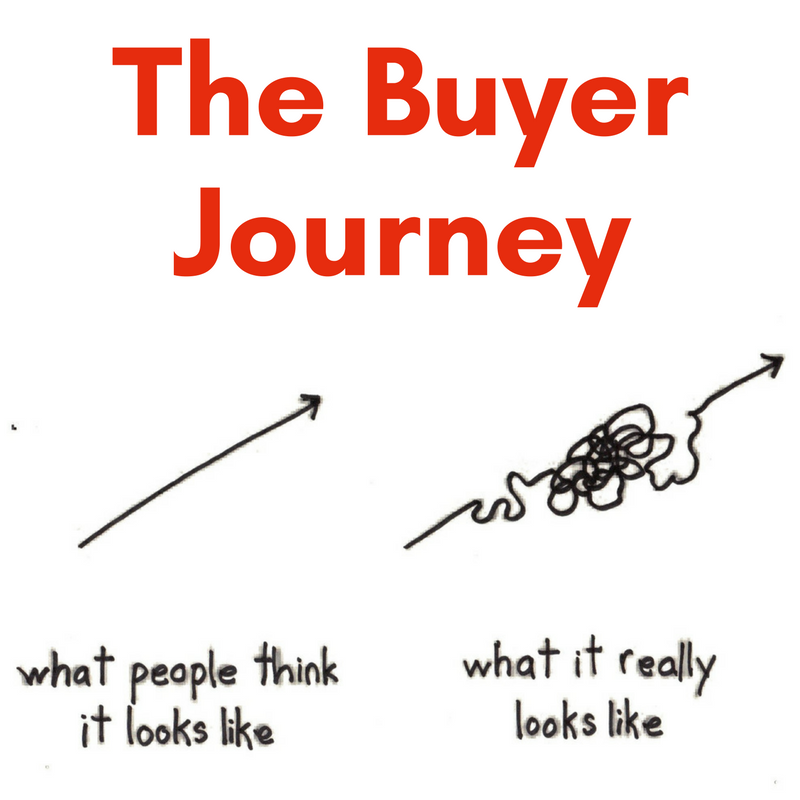After realizing you had just lost a sale, have you ever taken the “Sales Walk of Shame” back to your car and asked yourself, “What just happened?”
You didn’t see it coming.
In your mind, everything looked great.
Your buyer assured you that things were fine and going well.
Somehow, somewhere, though…somebody else sunk your ship.
I’ve personally endured this painful lesson many times. I talk through such tough losses with salespeople in “post mortem” discussions, taking up what went wrong and how to avoid once again being blindsided.
Most often the primary reason you have that rug pulled out from under you is that you’re not totally aware of who is pushing hardest for their interest in a deal–who is calling the shots.
We generally picture in our minds a buying process that is numbers based, linear, analytical or straightforward. In truth, though, the process looks more like this diagram:
Be it the owner of a small business, or an enterprise organization purchasing agent, who is really calling the shots may not always be obvious, clear or documented
A dozen or so years back, I happened to meet with the owner of a local furniture store. I contacted him about advertising on our TV station, and had conducted all possible due diligence. I met with him several times, and he assured me he was the owner and sole decision maker. I answered all of his questions and he accepted my proposal, assuring me that his response would be a big THUMBS UP for my proposed package.
My next visit, though, brought me a sucker punch: he informed me that they would be keeping their advertising with their current channel because his parents preferred the news anchors and weatherman of that station.
“What?!” Yes, despite what he had told me, it turned out his parents were really calling the shots. He might have been the owner, but it was they who determined where money was spent.
Looking back, I realized that there had actually been signs that I had missed, and if I had caught them I could have been saved some heartache.
For instance, he would never make a decision right away, he asked questions in emails after our meeting, I didn’t see him make decisions in front of other staff, and the administrative staff around him didn’t ask him questions or bring issues to him when I was there.
Red Flags, in hindsight.
To save yourself from similar heartache, here are THREE ways to look for who’s really pulling the strings:
Feel out the position of your buyer. This comes with a disclaimer – DON’T go looking to open Pandora’s box and invite everyone in to weigh in on the decision. But feel out how much influence or weight your buyer has by talking to those around them. I’ve found talking to receptionists, admins, and support personnel to be incredibly helpful – asking about what kind of big things are happening, what does our buyer have on their plate, et cetera. You’ll get a good picture of what they’re truly tasked with doing and if they are really entrusted with making the purchasing decision from you.
Go Up/Down stream. Similar to the first point, expand your reach beyond the one buyer to those who are impacted upstream or downstream by this purchase or change in vendor/product. For complex sales that require implementations or products that impact multiple departments, getting various perspectives and input can give you selling insights, but also enlighten you as to how decisions are really made within an organization.
For instance, when selling digital print services within a healthcare organization, the purchasing agent I was dealing with was hell bent on not letting me meet or talk to anyone in HR, Marketing, or Administration. I kept pressing the issue until he truly had no answers and had to let me talk directly to the Marketing Director. When I did finally talk to her, I learned that she, as well as several of her counterparts, were extremely unhappy with the paper quality and products he was ordering. They were going to can ME because of decisions the buyer was making independently! I was then able to educate them and build relationships with those directors and secure my foothold in the organization as someone they trusted to deliver what they wanted.
Expanding your circles can expand your reach and give you access influence!
Listen and watch. If you are meeting with your prospective customers, managers, or members of their team, you can put your Emotional Intelligence skills to work and observe physical and verbal cues for those small clues as to who is really in charge:
What is body language telling you? Watch how your customers enter the room. Who leads? Who sits down first? Who sits at the head of the table? Also, observe their posture and body language to see who leans back and spreads out, taking up more room, or looks casual. That is a power move leaders can make. Often, those that lean in or put their hands on the table are anxious to do business with you – especially if they use multiple gestures. Read up on body language or find a video on YouTube such as this one, which breaks down a ton of those nonverbal cues.
Who repeats themselves? I’ve found this signal very telling. If there’s someone in your meeting who repeats themselves or specific points, chances are, they’re extremely vested in either the results or the outcome of the purchase going their way. It could be that they are tied to the success of the implementation and results, OR, they could have some personal interest in which vendor or product is used. That’s rare, but keeping great relationships can be extremely compelling and turn influencers into advocates for their choice.
Who hesitates to answer? This is one small gesture I liken to a poker “tell.” When your potential customer and members of their organization are gathered around the table, look for small hesitations before answers, ESPECIALLY, if your responder quickly glances at someone else at the table. Follow their eyes and where their body is directed to see the “authority” in the room or to see if they’re checking for anyone’s approval.
Hesitations may also be a sign that they don’t truly have the final say in what criteria they are making decisions about. This has bitten me in the butt plenty of times. Building a proposal around what you THINK is useful to the organization without vetting it thoroughly can backfire as it did with my prospects who owned the furniture store.
Those “Sucker Punch” feelings are still really strong and memorable when I think of all the time and effort I put into those deals that I was so sure I had locked up. It’s the feeling of surprise and even deception that registered the strongest for me.
After several of those big disappointments (and, embarrassments), I started looking for those signs that I was or was NOT working with those who could truly make the decision or influence the outcomes.
Pulling back the curtains on the great OZ saved me a ton of heartache and wasted sales time. Get to know the signs that you’re dealing with the REAL decision makers.
Until next time, stop hoping, start SELLING!
[poll id=”10″]
What has been your experience in really sounding out your buyer? Leave a comment and let us know.
Pipeliner CRM empowers salespeople to truly track buyers and their signals. Get your free trial of Pipeliner CRM now.


Comments